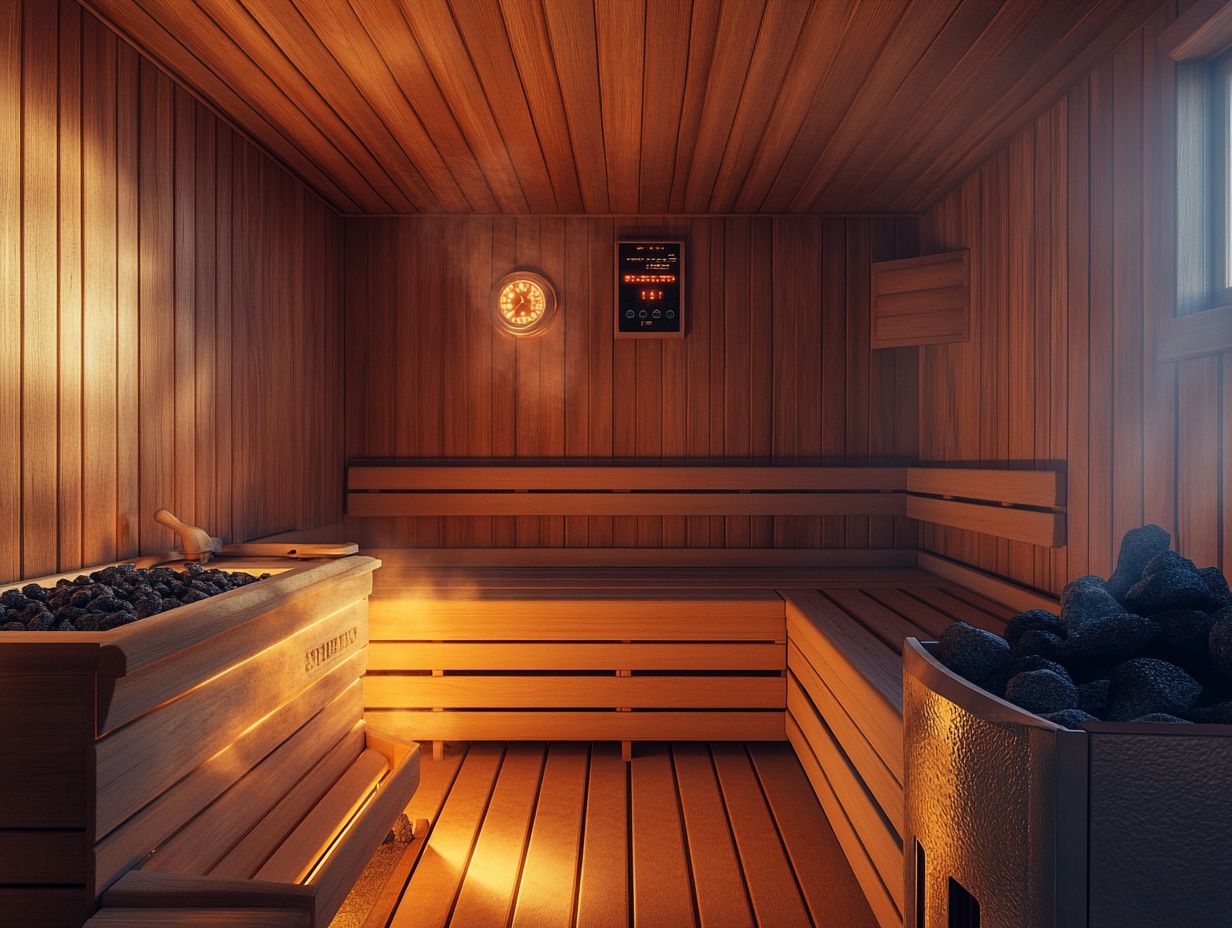Sauna Temperature Guidelines for Safety
Are you interested in discovering the ultimate sauna experience? Identifying the ideal temperature is essential for both your enjoyment and safety.
This article delves into what a sauna truly is, outlines the optimal temperature range for a secure session, and highlights the risks associated with excessive heat exposure.
You ll also uncover vital tips for ensuring your safety while savoring the steam, as well as alternative sauna options designed to meet various preferences and needs.
Get ready to transform how you relax in the sauna!
Contents
- Key Takeaways:
- Optimal Sauna Temperature for Safety
- Potential Risks of High Sauna Temperatures
- Sauna Temperature Tips and Precautions
- Alternatives to High Temperature Saunas
- Frequently Asked Questions
- What is considered a safe sauna temperature?
- Can I adjust the sauna temperature for personal preference?
- Are there any health risks associated with high sauna temperatures?
- Is it safe to have multiple people in the sauna at the same time?
- Can I stay in the sauna for as long as I want at a safe temperature?
- What should I do if I start feeling lightheaded or dizzy in the sauna?
Key Takeaways:

- The optimal sauna temperature range for safety is between 150 F and 195 F (65 C to 90 C).
- High temperatures in saunas can cause dehydration, heat exhaustion, heat stroke, and other adverse effects on health.
- Stay safe and hydrated! Remember to limit your time inside and monitor the sauna’s temperature.
What is a Sauna?
A sauna is a charming little retreat, a small room or building crafted for indulging in dry or wet heat sessions. It finds its roots in places like Scandinavia and Turkey, where you can explore various types, including steam saunas, dry saunas, and infrared saunas. Even the American adaptations offer unique approaches to sauna experiences.
Each type boasts its own origins and benefits: steam saunas, steeped in Finnish tradition, deliver a delightful moist heat that envelops you in a soothing embrace. Infrared saunas use light to heat your body, promoting relaxation and aiding detoxification.
The health benefits of sauna use are plentiful, ranging from improved cardiovascular health to enhanced skin conditions. To truly savor the experience, it’s crucial to follow safety guidelines, sauna safety: the role of collaboration, stay hydrated, and keep an eye on your session duration.
Saunas hold cultural significance in many regions. From lively social interactions in Finnish saunas to the therapeutic rituals of Turkish hammams, they represent more than just a wellness tool; they are communal spaces that foster connection and shared experiences.
Optimal Sauna Temperature for Safety
The ideal sauna temperature for your safety typically falls between 150 F and 195 F (65 C to 90 C). This range allows you to bask in the health benefits of sweating while avoiding the risks that come with excessive heat exposure.
Mastering temperature control is crucial for maintaining optimal humidity levels during your sauna sessions, significantly enhancing your overall experience. This approach not only improves your comfort but also aligns with guidelines for family use set by health organizations for a safe sauna environment.
Recommended Temperature Range
The ideal temperature range for various types of saunas steam, infrared, and traditional typically falls between 150 F and 195 F (65 C and 90 C). This range allows you to fully enjoy the therapeutic benefits that saunas offer.
Staying within this temperature bracket ensures you can take advantage of the many health perks associated with regular sauna use, such as enhanced circulation, detoxification, and muscle relaxation. For instance, steam saunas operate best at lower temperatures, creating a moist, warm environment that many find soothing. Traditional saunas can reach higher temperatures, delivering an invigorating experience that encourages sweating and rejuvenation. It’s also important to be aware of sauna safety policies to maximize your experience.
As highlighted by the North American Sauna Society, maintaining these optimal temperatures is essential for maximizing your comfort and achieving the wellness outcomes you desire. For more insights on this topic, including sauna safety and the role of technology, ultimately, personal preference plays a pivotal role in selecting the sauna type that suits you best.
Potential Risks of High Sauna Temperatures

While saunas provide a wealth of health benefits, it s crucial to recognize that high temperatures can carry certain risks, including heat exhaustion and heat stroke. These serious conditions can develop from spending too long in high heat.
The World Health Organization highlights the importance of understanding these risks to promote safe sauna practices, especially for those with pre-existing health conditions or individuals prone to dizziness during their sessions.
Prioritizing awareness will help you enjoy the invigorating experience of the sauna while keeping your well-being in check.
Effects on the Body and Health
The effects of sauna sessions on your body can be nothing short of transformative. They offer a myriad of health benefits, including improved cardiovascular health, enhanced sweating, and a deep sense of relaxation.
Incorporating regular sauna use into your routine can significantly boost your overall wellness. The heat from the sauna encourages blood vessel dilation (which means widening), improving circulation and potentially lowering blood pressure. This process of sweating is not just about feeling good; it plays a vital role in detoxifying your body by flushing out accumulated toxins. To ensure a safe experience, it’s important to be aware of sauna safety regulations.
Beyond the physical advantages, saunas provide a tranquil escape for your mind, effectively reducing stress and anxiety.
It’s essential to prioritize safety by staying hydrated, limiting session durations, and tuning in to what your body is telling you. This ensures that each sauna experience is both enjoyable and beneficial.
Sauna Temperature Tips and Precautions
Unlock the full potential of sauna health benefits while prioritizing safety. Adhere to specific temperature control tips and precautions. This includes following the recommended guidelines for session duration and paying attention to your personal comfort levels.
By doing so, you ll ensure a rewarding and safe sauna experience.
How to Stay Safe in the Sauna
- Monitor your heat exposure and be mindful of any dizziness, especially if you’re new to sauna sessions.
- Staying hydrated is key before, during, and after each visit; the heat can lead to considerable fluid loss. Always have a water bottle within reach to sip from.
- Recognizing the early signs of overheating, such as a rapid heartbeat or lightheadedness, is crucial. If you experience these symptoms, exit the sauna immediately.
- According to the North American Sauna Society, adhering to recommended session limits typically no more than 15 to 20 minutes can elevate your experience while minimizing health risks.
- Allow your body some time to cool down afterward to restore its natural equilibrium.
Alternatives to High Temperature Saunas

For individuals who prefer a gentler sauna experience, you ll find excellent alternatives to traditional high-temperature saunas.
Consider options like the infrared sauna or steam sauna, both of which cater to different preferences for personal comfort while still offering a wealth of health benefits, including detoxification and relaxation. Additionally, understanding sauna safety in social situations can enhance your experience.
Other Sauna Options for Different Needs
Explore various sauna options tailored just for you like infrared, steam, and dry saunas. Each option caters to your unique preferences and health needs, allowing you to curate an experience that truly benefits you.
Infrared saunas use radiant heat. This heat penetrates deeper into your skin than traditional methods, enhancing detoxification (the process of removing toxins from your body) and easing muscle pain like a warm embrace.
Steam saunas create a humid sanctuary. They are ideal for opening your airways that help you breathe and hydrating your skin, leaving you refreshed and rejuvenated.
Dry saunas feature high temperatures and low humidity. They promote relaxation and support cardiovascular health, ensuring you can find the perfect fit that aligns seamlessly with your lifestyle and health goals.
Frequently Asked Questions
What is considered a safe sauna temperature?
The recommended safe sauna temperature is between 150-195 F (65-90 C). Temperatures above this range can be dangerous and should be avoided.
Can I adjust the sauna temperature for personal preference?

Yes, you can adjust the temperature based on your personal preference. However, it is important to stay within the safe temperature range to avoid any potential hazards.
Are there any health risks associated with high sauna temperatures?
High sauna temperatures can risk your health, leading to dehydration, overheating, and heat stroke. It’s important to monitor the temperature and listen to your body’s signals.
Is it safe to have multiple people in the sauna at the same time?
Yes, you can enjoy the sauna with friends! Just keep the temperature within the recommended range and ensure everyone is aware of any health conditions that may be affected by the heat.
Can I stay in the sauna for as long as I want at a safe temperature?
It is not recommended to stay in the sauna for extended periods, even at a safe temperature. The recommended time is generally between 10-20 minutes, with breaks in between to cool down and rehydrate.
What should I do if I start feeling lightheaded or dizzy in the sauna?
If you feel lightheaded or dizzy, leave the sauna immediately. Cool down and rehydrate. If symptoms persist, seek medical attention.






